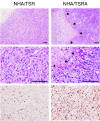O6-methylguanine-DNA methyltransferase is downregulated in transformed astrocyte cells: implications for anti-glioma therapies
- PMID: 17547775
- PMCID: PMC1892783
- DOI: 10.1186/1476-4598-6-36
O6-methylguanine-DNA methyltransferase is downregulated in transformed astrocyte cells: implications for anti-glioma therapies
Abstract
Background: A novel alkylating agent, temozolomide, has proven efficacious in the treatment of malignant gliomas. However, expression of O6-methylguanine-DNA methyltransferase (MGMT) renders glioma cells resistant to the treatment, indicating that identification of mechanisms underlying the gene regulation of MGMT is highly required. Although glioma-derived cell lines have been widely employed to understand such mechanisms, those models harbor numerous unidentified genetic lesions specific for individual cell lines, which complicates the study of specific molecules and pathways.
Results: We established glioma models by transforming normal human astrocyte cells via retroviral-mediated gene transfer of defined genetic elements and found that MGMT was downregulated in the transformed cells. Interestingly, inhibitors of DNA methylation and histone deacetylation failed to increase MGMT protein levels in the transformed astrocyte cells as well as cultured glioblastoma cell lines, whereas the treatment partially restored mRNA levels. These observations suggest that downregulation of MGMT may depend largely on cellular factors other than promoter-hypermethylation of MGMT genes, which is being used in the clinic to nominate patients for temozolomide treatment. Furthermore, we discovered that Valproic acid, one of histone deacetylase inhibitors, suppressed growth of the transformed astrocyte cells without increasing MGMT protein, suggesting that such epigenetic compounds may be used to some types of gliomas in combination with alkylating agents.
Conclusion: Normal human astrocyte cells allow us to generate experimental models of human gliomas by direct manipulation with defined genetic elements, in contrast to tumor-derived cell lines which harbor numerous unknown genetic abnormalities. Thus, we propose that the study using the transformed astrocyte cells would be useful for identifying the mechanisms underlying MGMT regulation in tumor and for the development of rational drug combination in glioma therapies.
Figures






Similar articles
-
Regulation of expression of O6-methylguanine-DNA methyltransferase and the treatment of glioblastoma (Review).Int J Oncol. 2015 Aug;47(2):417-28. doi: 10.3892/ijo.2015.3026. Epub 2015 May 29. Int J Oncol. 2015. PMID: 26035292 Free PMC article. Review.
-
Careful exclusion of non-neoplastic brain components is required for an appropriate evaluation of O6-methylguanine-DNA methyltransferase status in glioma: relationship between immunohistochemistry and methylation analysis.Am J Surg Pathol. 2008 Aug;32(8):1220-7. doi: 10.1097/PAS.0b013e318164c3f0. Am J Surg Pathol. 2008. PMID: 18580490
-
Inhibition of histone deacetylation potentiates the evolution of acquired temozolomide resistance linked to MGMT upregulation in glioblastoma xenografts.Clin Cancer Res. 2012 Aug 1;18(15):4070-9. doi: 10.1158/1078-0432.CCR-12-0560. Epub 2012 Jun 6. Clin Cancer Res. 2012. PMID: 22675172 Free PMC article.
-
Inhibition of DNA-repair genes Ercc1 and Mgmt enhances temozolomide efficacy in gliomas treatment: a pre-clinical study.Oncotarget. 2015 Oct 6;6(30):29456-68. doi: 10.18632/oncotarget.4909. Oncotarget. 2015. PMID: 26336131 Free PMC article.
-
A novel approach to overcome temozolomide resistance in glioma and melanoma: Inactivation of MGMT by gene therapy.Biochem Biophys Res Commun. 2011 Mar 18;406(3):311-4. doi: 10.1016/j.bbrc.2011.02.042. Epub 2011 Feb 15. Biochem Biophys Res Commun. 2011. PMID: 21329652 Review.
Cited by
-
Genomic analysis of diffuse intrinsic pontine gliomas identifies three molecular subgroups and recurrent activating ACVR1 mutations.Nat Genet. 2014 May;46(5):451-6. doi: 10.1038/ng.2936. Epub 2014 Apr 6. Nat Genet. 2014. PMID: 24705254 Free PMC article.
-
Interleukin-24 overcomes temozolomide resistance and enhances cell death by down-regulation of O6-methylguanine-DNA methyltransferase in human melanoma cells.Mol Cancer Ther. 2008 Dec;7(12):3842-51. doi: 10.1158/1535-7163.MCT-08-0516. Epub 2008 Dec 3. Mol Cancer Ther. 2008. PMID: 19056673 Free PMC article.
-
Comprehensive Glycomics of a Multistep Human Brain Tumor Model Reveals Specific Glycosylation Patterns Related to Malignancy.PLoS One. 2015 Jul 1;10(7):e0128300. doi: 10.1371/journal.pone.0128300. eCollection 2015. PLoS One. 2015. PMID: 26132161 Free PMC article.
-
Structure-changeable luminescent Eu(III) complex as a human cancer grade probing system for brain tumor diagnosis.Sci Rep. 2024 Jan 22;14(1):778. doi: 10.1038/s41598-023-50138-9. Sci Rep. 2024. PMID: 38253656 Free PMC article.
-
Valproic acid-induced changes of 4D nuclear morphology in astrocyte cells.Mol Biol Cell. 2021 Aug 19;32(18):1624-1633. doi: 10.1091/mbc.E20-08-0502. Epub 2021 Apr 28. Mol Biol Cell. 2021. PMID: 33909457 Free PMC article.
References
-
- Kleihues P, Burger PC, Scheithauer BW. The new WHO classification of brain tumours. Brain Pathol. 1993;3:255–268. - PubMed
-
- Kleihues P, Louis DN, Scheithauer BW, Rorke LB, Reifenberger G, Burger PC, Cavenee WK. The WHO classification of tumors of the nervous system. J Neuropathol Exp Neurol. 2002;61:215–225. discussion 226–219. - PubMed
Publication types
MeSH terms
Substances
LinkOut - more resources
Full Text Sources
Research Materials

